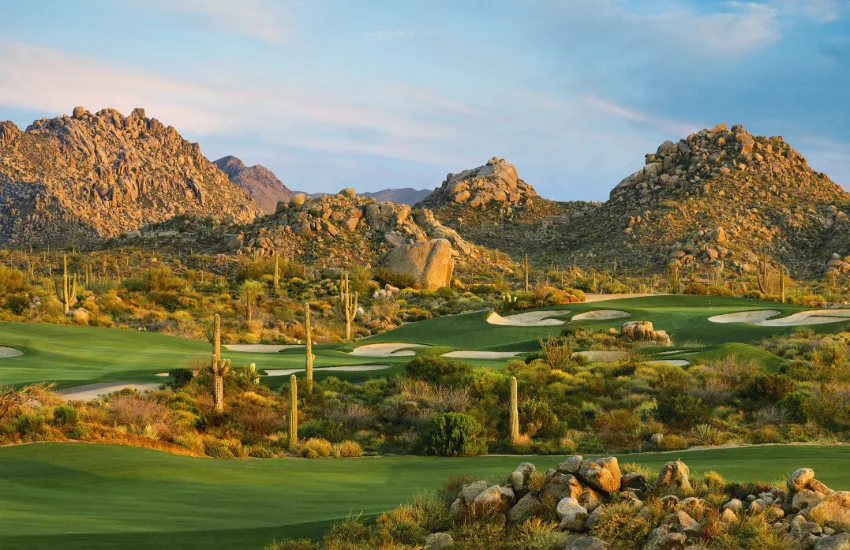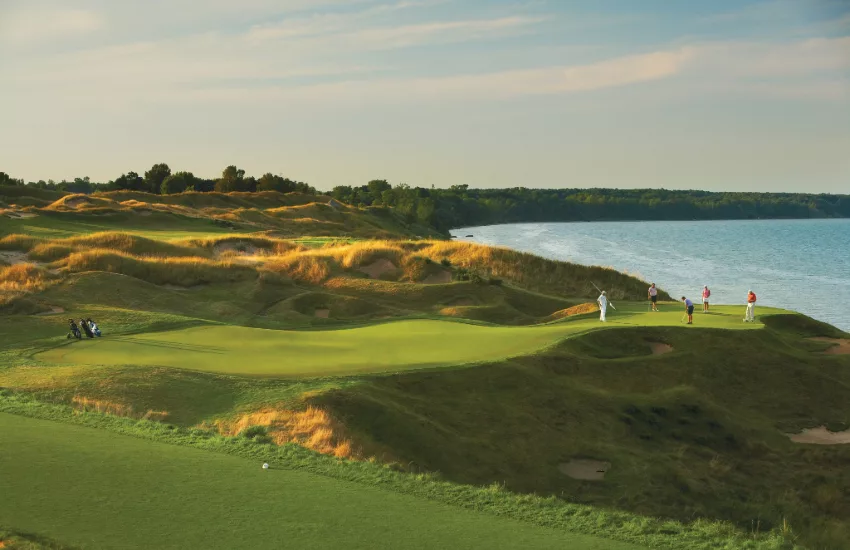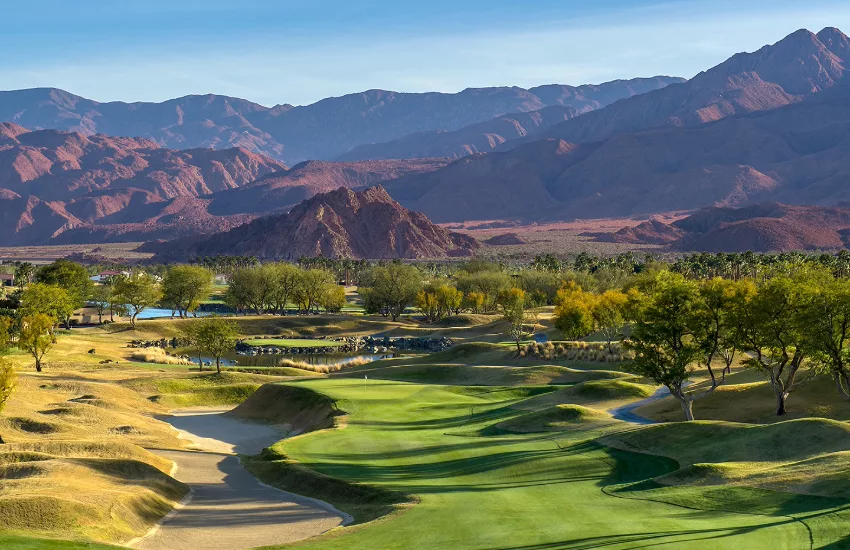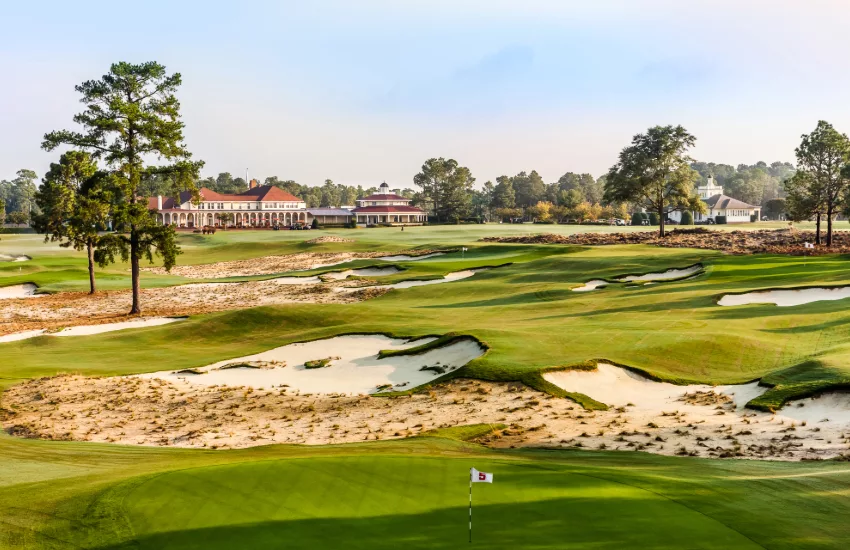
If you’re anything like us, we know your daydreams are filled with visions of the golf course. But wait, where are we? Are we nestled in the rolling hills of the Scottish Highlands, the salty ocean breeze rustling through fescue grasses? Or perhaps we’re in the heart of the desert, where the fairways stretch out like ribbons of green against the backdrop of rugged mountains that’ll make you feel like you’re playing on Mars.
Needless to say, the types of golf courses are as diverse as the players who love them. Each course possesses its own unique character, challenges, and design, largely influenced by the surrounding natural terrain and ecosystem. Despite their individuality, all golf courses can fall into one (or more) of seven categories. You’ve likely heard about the different types of golf courses, but do you know what makes each one unique?
Explore the Different Types of Golf Courses
1. Types of Golf Courses: Links Courses

Originating in Scotland, the birthplace of golf, authentic links golf courses are some of the oldest in the world. The term “links,” derived from the Old English word “hlinc,” meaning ridge or rising ground, perfectly captures the terrain that defines these courses.
Links courses are rooted in practicality, often situated on sandy soil that was of little use to farmers centuries ago. This sandy terrain, located near bodies of water, became the perfect canvas for golf, featuring undulating fairways, deep bunkers, and natural hazards like tall grasses and dunes that blend seamlessly with the landscape. The ever-changing weather adds an element of unpredictability, too, which makes these courses all the more fun to play.
The Old Course at St. Andrews is perhaps the most renowned links course globally, famed for its pot bunkers, large double greens, and iconic landmarks such as the Swilcan Bridge and Hell Bunker. Other notable links courses include Royal County Down and, back within US borders, Pebble Beach Golf Links and the collection of golf courses at Bandon Dunes Golf Resort.
2. Types of Golf Courses: Parkland Courses

With their lush, tree-lined fairways and manicured landscaping, parkland courses are a stark contrast to the rugged, windswept designs of links courses. Parkland courses are normally found inland, off the coast, in park-like settings – hence the name.
Typically, these courses are meticulously groomed, and enhanced with elements like crafted bunkers, water features, and longer roughs. Augusta National Golf Club, home of The Masters, is a great example. Parkland courses are often located in regions that may not be naturally predisposed to golf, which makes their maintenance and upkeep more challenging and costly. The terrain’s lack of natural undulations and variety demands more from course architects, too, pushing them to transform the landscape.
3. Types of Golf Courses: Heathland Courses

The term “heathland” refers to open, unspoiled land, primarily found in Britain, characterized by vegetation like heather, gorse, and rough grasses. Heathland courses draw inspiration from links courses and have more open layouts compared to parkland courses.
One of the most well-known heathland courses is Sunningdale Golf Club in England which features two championship courses, Old and New. Another notable example is The Berkshire Golf Club, also in England, celebrated for its natural beauty and challenging design.
Heathland courses are one of the most rare types of golf courses in the United States, with only a select few (around 20 to 30 courses) meeting the criteria to be classified as heathland-style. Whistling Straits in Wisconsin is a prime example.
4. Types of Golf Courses: Sandbelt Courses

The Sandbelt region in Australia boasts some of the world’s most revered golf courses, although they can sometimes be overlooked due to their location. Situated just outside Melbourne, the sandbelt is home to several of the finest courses globally, thanks to its uniquely sandy soil, which is ideal for golf.
The Melbourne Sandbelt region is a result of a prehistoric flood that deposited heavy sandstone into low-lying areas. This sandy loam can reach depths of up to 80 meters in some places, creating the perfect foundation for undulating greens and firm, fast-playing surfaces.
While all courses in the area are exceptional, standout venues include Royal Melbourne Golf Club and Kingston Heath Golf Club.
5. Types of Golf Courses: Desert Courses

Desert golf courses, as their name suggests, are set amidst desert landscapes, featuring rugged terrain with rocks, cacti, and sandy areas. The key objective on these golf courses, as with any, is to keep the ball in play. However, on desert courses, the challenge is heightened due to the unforgiving terrain.
While the absence of dense vegetation can make it easier to locate errant shots, it also means that stray balls are more likely to end up in hazardous areas, such as among cacti.
One of the most famous desert courses is the Stadium Course at TPC Scottsdale in Arizona, host of the Waste Management Phoenix Open. Other notable desert courses in the area include Troon North and We-Ko-Pa Golf Club.
6. Types of Golf Courses: Championship & Stadium Courses

The terms “championship course” and “stadium course” are often used interchangeably, but they have distinct characteristics.
A championship course is typically designed to host golf tournaments, ranging from local events to major championships. When a club advertises a “Championship Course,” it usually indicates that the course is 18 holes, lengthy, and challenging. This term can also be used to differentiate between multiple courses at a club.
Stadium courses, on the other hand, have a more specific definition. The majority of stadium courses are TPC (Tournament Players Club) courses, designed with spectators in mind for PGA Tour events. These courses are laid out to allow easy movement of spectators and often feature elevated vantage points and exciting holes.
7. Types of Golf Courses: Par 3 Courses

Par 3 courses, also known as short courses or pitch and putt courses, are a delightful twist on traditional golf. These courses feature shorter holes, typically ranging from 100 to 200 yards, making them perfect for beginners, juniors, or anyone looking to sharpen their short game. Despite their shorter length, par 3 courses can be surprisingly challenging, with small greens, strategic bunkering, and the occasional water hazard keeping you on your toes.
Many major clubs, like Augusta National, boast par-3 courses alongside their traditional 18-hole layouts. Resorts are also jumping on the short course trend, with Sand Valley’s Sandbox, Pinehurst’s The Cradle, and Bandon Dunes’ The Preserve.
Check out our list of the best golf short courses in North America.
As we wrap up our journey through the different types of golf courses, it’s clear that there’s something special for every golfer out there. Whether you’re drawn to the rugged charm of seaside links or the tranquility of a parkland layout, each fairway offers its own unique adventure.
So as you travel to the various types of golf courses, make your journey there and back smoother by using Ship Sticks to ship your clubs ahead. No more lugging your clubs through airports or worrying about whether they’ll make it to your destination in one piece. Just smooth, stress-free travel for golfers like you.